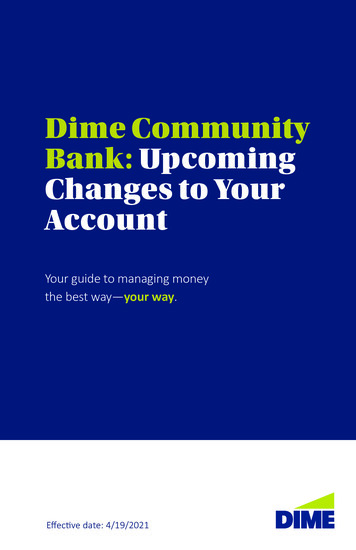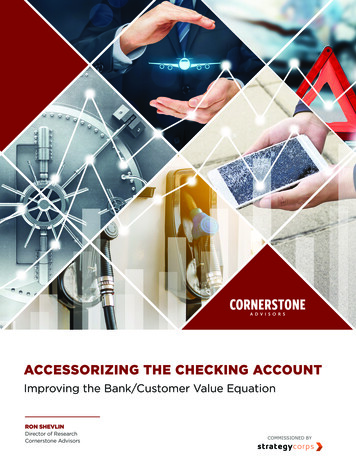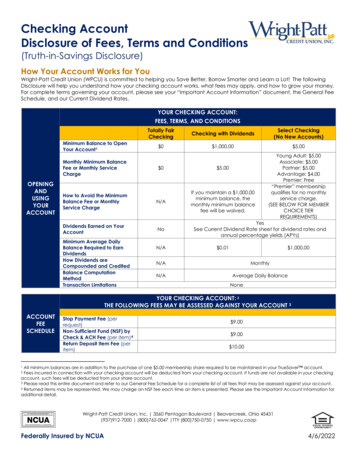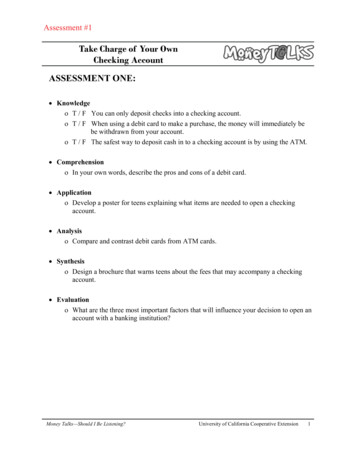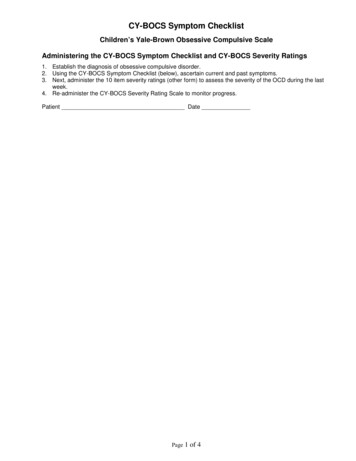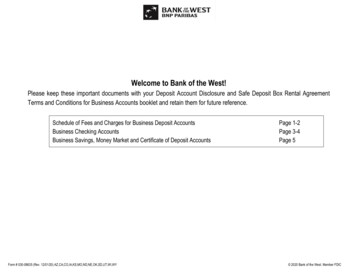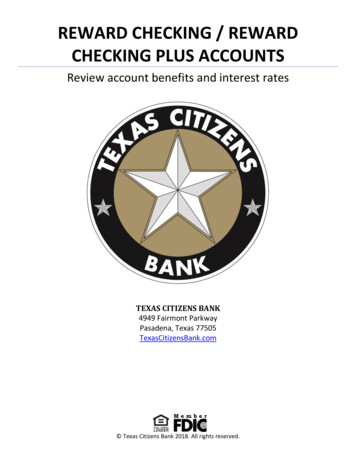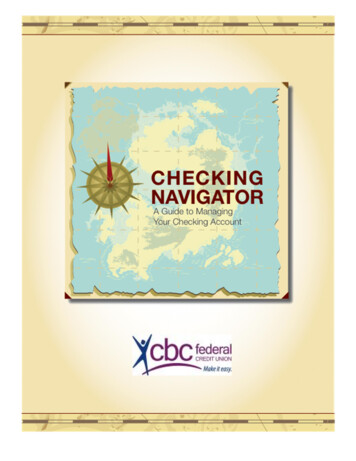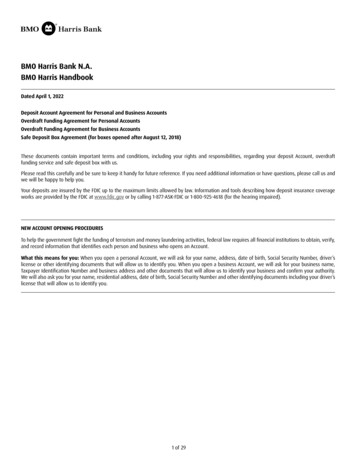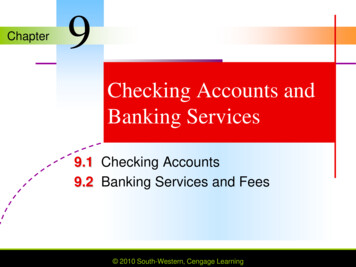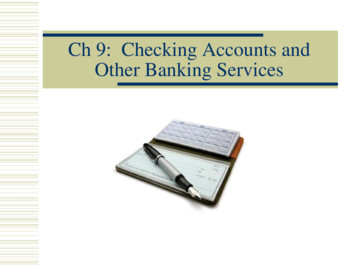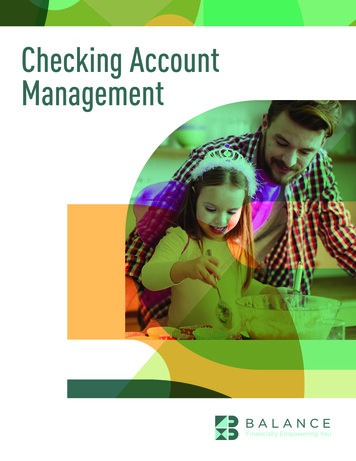
Transcription
Checking AccountManagement
Whether you have a history of overdraft or non-sufficient funds chargesor you just want to know how to best manage your first checking account,this booklet will give you the tools and information needed to become andremain a successful checking account holder. You will learn key componentsof wise checking account management, including checking accountfundamentals, deposits, withdrawals, keeping your account in goodstanding, and protecting your account.Checking Account FundamentalsA checking account is a service provided by financial institutions that allows you to deposit money with them and withdraw it at a later date.Checking accounts typically come with a low or no interest rate, but you can access your money almost anywhere, and there is usually nolimit to how many withdrawals you can make in a month. In contrast, savings accounts and certificates of deposit (CDs) come with a higherinterest rate but restrict or penalize withdrawals. Most people use a checking account for day to day money management, such as paying forgroceries and clothing, and a savings account and/or certificate of deposit for saving.You may be wondering if having a checking account is truly safe. Some people avoid opening one because they fear that they will lose all oftheir money if their financial institution goes out of business. Instead, they use check-cashing stores and carry around large amounts of cash.This is not a good idea. Check-cashing places charge exorbitant fees, much higher than the fees charged by traditional financial institutions(if they charge any at all). Furthermore, while you can cancel a lost or stolen debit card or check, if you lose cash or are robbed, the money isgone forever. The safest place to keep your money is in a financial institution - banks and credit unions are insured, so within limits, even ifyour financial institution were to go out of business, you would not lose your money.Types of AccountsThere are several different types of checking accounts:Individual: As the name implies, an individual account only has one owner. Some financial institutions offer one basic checking account,while others offer a few. If you have a choice, look at the features of each account, such as the fees, minimum required balance, and servicesprovided, and decide which one best meets your needs.Joint: A joint account is similar to an individual account, only there is more than one account holder. Because any account holder canwithdraw all of the money from the account, you should only get a joint account with someone you trust.Senior/student/teen: Some financial institutions, particularly credit unions, offer special checking accounts for seniors, college students,and/or teens. These accounts typically come with a low or no minimum required balance and minimal or no fees.Business: A business checking account is intended for people who own their own business and want a separate accountto handle its finances.1
Opening a Checking AccountAlthough some institutions let you apply for a checking account online, most people apply in person at their local branch. Since opening anaccount can take several minutes, only go when you have plenty of time, and remember to bring identification and funds to deposit with you.(The minimum required deposit varies, but generally, you cannot open a checking account with a zero balance.) An employee will fill out anapplication for you by collecting your personal information, including your name, address, phone number, and Social Security number. If yourapplication is approved, you will receive your new account number. You may also be given a limited number of checks, but the full checkbookand debit card will likely be mailed to you. Along with receiving everything you need to use your account, you should also be given a feeschedule. Be sure to read this carefully to understand what fees you are being and could be charged.Getting a checking account is an easy process for most people. However, if you have a ChexSystems report, it could be a challenge.ChexSystems collects information on negative checking and savings account activity and provides the information to financial institutions.Negative activity includes writing fraudulent checks or committing other acts of fraud, bouncing checks, and overdrawing your account.There is no standard for reporting to ChexSystems – some financial institutions will report a check that bounced due to a miscalculation,where others may only report cases of fraud. If you have a ChexSystems report, you can get a free copy of it once a year by visitingwww.chexsystems.com or calling 800.428.9623.Some financial institutions also check your credit report when you apply for a checking account. Unlike with ChexSystems, your credit reportmonitors both positive and negative credit activity. Having a history of late payments or a bankruptcy, judgment, repossession, or foreclosureon your credit report can make it difficult to get a checking account. You can get a free copy of your credit report from all three credit bureausyearly through the Annual Credit Report Request Service (www.annualcreditreport.com or 877.322.8228).Are you doomed to keeping your money in a shoebox if you have a ChexSystems report or negative information in your credit report? Notnecessarily. If you are initially denied, talk to your financial institution about what you can do. If you have an outstanding debt, you may beable to get a checking account if you pay it. Your financial institution may also be willing to let you open an account if you complete a courseon checking account management.DepositsEndorsing a checkEven in this electronic age, the check is still the payment method used by many employers (and doting grandparents!). In order to depositor cash a check, you first need to endorse it. This is also true when using mobile deposit from your mobile device. There are three basictypes of endorsements:Blank endorsement: A blank endorsement is made by signing your name on the back of the check. You must sign it exactly the way itappears on the “Pay to the Order of” line. Anyone can cash or deposit a check with a blank endorsement, even if the check is not written tohim or her. You should only do a blank endorsement if you are cashing a check, and don’t sign it until you are at the financial institution.Jane Public2
Restrictive endorsement: A restrictive endorsement is made by writing “For deposit only” on the first line of the back of the check and thensigning your name underneath. When using mobile deposit, you should write “for mobile deposit only” along with your signature below.A check with a blank endorsement can only be deposited into an account in your name. Some financial institutions also prefer that you writeyour account number on the check to make it easier to process. However, others see this as a security risk, and ask you not to write youraccount number on the check.For deposit onlyFor deposit onlyJane PublicAccount#01234567 89Jane PublicSpecial endorsement: A check is signed with a special endorsement when you want to give your check to another person. It is differentfrom a blank endorsement in that the check can only be cashed or deposited by the person you are assigning the check to. To do a specialendorsement, write “Pay to the order of [name of person you are giving check to]”, and sign your name underneath.Pay to the order of John SmithJane PublicDepositing Checks and CashIn order to deposit cash, you must go to the financial institution and see a teller or use an ATM. Checks can be deposited the same way orremotely by mobile device.To make a deposit with a teller, you need to fill out a deposit slip. You may have deposit slips in your checkbook that already have youraccount number printed on it. When you are filling out the amount(s) you are depositing, remember to write in the correct section –generally, there are different sections for currency (paper cash), coin, and check deposits. List each check separately, and use the back sideif needed. If you want to receive some cash back from a check you are depositing, you should write that amount in the “Less Cash Received”section. (You may not need to fill out a deposit slip if you are cashing the full amount of a check.)3
If you are using an ATM, first read the instructions for making a deposit. All ATMs require you to insert your debit or ATM card and enteryour pin number, but while some ask you to fill out a deposit slip and insert the slip and deposit into the machine in an envelope, othersallow you to directly insert checks or cash into the machine without an envelope or deposit slip. Remember to save your receipt, and whenyou receive your statement or check your account activity online, verify that your balance was properly credited.When you deposit a check, it is common for all or part of the funds to be placed on hold (unavailable for withdrawal) while the check isbeing processed. Even if you cash a check, a hold will often be placed on an equivalent amount of money in your account. Once the money isdeducted from the check writer’s account, the hold is lifted. Processing time varies, but it is usually no more than a few business days.However, if the amount of the check is greater than the funds in the check writer’s account, the check may bounce. If this happens, youwill not get the money from the check. In addition, your financial institution may charge you a fee. If someone gives you a check that laterbounces, you should immediately contact that person and give him or her the opportunity to correct the situation – this can include payingyou the amount of the bad check (you may want to insist on payment in cash) as well as any fees you are assessed.Mobile depositMake sure to download a legitimate app from your financial institution by visiting their web site first. After endorsing your check withsignature and “For mobile deposit only,” simply follow the app instructions on entering the dollar amount and taking a photo of the front andback part of the check. Make sure to verify that the numbers on the bottom of the check can be seen in the photo before submiting. Also, it’simportant to wait for confirmation from your financial institution that the funds have been deposited, so don’t destroy the check immediately.If it helps to prevent confusion, make a small mark on the check to remind yourself that it has been deposited. In order to reduce fraud, mostfinancial institutions set limits on deposits made with a mobile device. Find out how much you’re allowed to deposit per day or per month,and if there are limits on the number of checks you can deposit.Direct depositDirect deposit is deposit method in which money is electronically transferred into your account without the issuance of a paper check. Thismethod is frequently used for employee paychecks and government benefits, such as Social Security and unemployment insurance. If youremployer offers direct deposit, you may want to take advantage it. Direct deposit is convenient – you don’t have to be constantly running toa financial institution to deposit your paychecks. You also do not have to worry about your checks getting lost or stolen. Furthermore, directdeposits are often processed quicker than paper checks, giving you access to the money sooner.To enroll in direct deposit, ask your employer for a sign-up form. In addition to providing your account information on the form, you may alsoneed to supply a voided check. To void a check, simply write the word “VOID” across it. Once the direct deposit is set up, you should monitoryour account to make sure that the money is being properly deposited. If there are any problems, notify your employer immediately.WithdrawalsDebit cardsA debit card (also called a check card) looks like a credit card, but it functions like a combination ATM card/check. ATM cards are used toaccess – what else? – ATMs. ATMs allow you to do many banking transactions, such as deposit checks, withdraw cash, and check your accountbalance. For security reasons, when you insert your ATM card, you must enter your pin number. (Either you will be given a pin number whenyou receive your card or have to create one before you can use it.) Memorize your pin number, and do not share it with anyone or carry it inyour wallet. You can use your debit card at any ATM, but be aware that if you use one that is not part of your financial institution’s network,you may be charged a fee.Like checks, debit cards allow you to pay your bills and make purchases in supermarkets, restaurants, and other stores. Many people findit more convenient to use their debit card than write a check, and, in fact, many stores today do not even accept checks. When you use yourcard, the cashier may ask, “Do you want to use debit or credit?” When you select the debit option, you are required to enter your pin numberin a keypad. In some stores, such as supermarkets, you are also given the option of getting cash back. There is typically no fee charged for thisservice. When you select the credit option, you are required to sign the receipt, unless the purchase amount is very small. You are also givensome protections that credit cards have. For example, if the item you purchased is defective, you can ask for a chargeback (a reversal of thecharge to your account). Neither option is inherently better than the other, but because of the additional protection provided, you may wantto choose the credit option for larger purchases.4
Keep in mind that regardless of whether you choose the credit or the debit option, a debit card does not work the same way as a credit card.When you use a credit card, you are borrowing money from the financial institution that issued that card, and you pay it back at a laterdate. If you want to buy a 100 pair of shoes with a credit card, it does not matter if you have a 100 the moment you buy it. (However, justbecause you can, does not mean you should use your credit card when you cannot afford to pay off the balance in full.) When you use yourdebit card, the money is immediately deducted from your checking account. If you only have 50 in your account, either the transaction willbe denied or, if approved, your account will become overdrawn and you may be charged a fee.ChecksEven if you use your debit card for most transactions, you probably will write checks at least once in a while. It is important to fill out thecheck correctly if you want to avoid having it returned to you. Always use a pen – this prevents someone from erasing what you wrote andwriting in something different. In the upper right corner, fill in the date that you are writing the check. In the “Pay to the Order of” line, writethe name of the person you are writing the check to. In the same line, after the “ ” sign, write the amount of the check in numbers. In theline underneath, write out the amount of the check in words, and sign your name in the lower right corner. Filling out the memo line of thecheck is optional but recommended – most people list what they are writing the check for or, if paying a credit card or other type of bill, theiraccount number. If you make any mistakes, write “VOID” across the check and fill out a new check.Home SuperstoreOctober 31, 2015Seventeen dollars and sixty five centsdecor17.65Jane PublicIt is easy to forget about a check once it leaves your hands. To prevent this from happening, take the time to note at least the followingfor every check you write: Check number (this alerts you if a check is missing in sequence) Date you wrote the check Who you wrote the check to What you wrote the check for The amount of the checkFurthermore, once the check is deposited and no longer outstanding, you should mark that as well. Most checkbooks come with a registerwhere you can record your check information. If not, a piece of paper or computer spreadsheet will do the trick.One very important difference between debit cards and checks is that when you write a check, the money is not deducted from your checkingaccount immediately. The money is only deducted once the person you wrote the check to brings it to his or her financial institution and thecheck is sent to your financial institution. (However, there are special types of checks that are pre-paid, namely certified and cashier’s checksand money orders. These types of checks may be required when you make certain purchases.)Since the money is not deducted right away, is it okay to write a check for more than amount you have in your account if you expect to depositmore money in the next day or two? No. This is called “floating”, and it is an extremely dangerous practice to engage in. While in the past itcommonly took several days for a check to be processed, checks today can be transmitted electronically and are processed much quicker. Ifthe check is processed before you deposit additional funds, your check could bounce or your account could become overdrawn.5
Electronic checksAn electronic check (also called an EFT payment) is essentially a personal check that is written online. Many lenders, utility providers,insurance companies, and other businesses accept electronic checks. By using this method, not only are you saving yourself a trip to the postoffice, but you also do not need to worry about your check getting lost or delayed in the mail. When you write an electronic check, the moneyis immediately deducted from your checking account, just like when you use your debit card. In fact, the only real difference between usingyour debit card and using an electronic check is the information you are required to input.In order to pay by electronic check, you must provide your routing number and account number. Sometimes a check number is also required.The diagram below shows where you can find this information on a check. Only submit electronic checks on secure sites (look for a webaddress starting with https or a lock icon), and remember to print out the payment confirmation page for your records.Automatic debitRouting #Check #Account #Automatic debit is the opposite of direct deposit – every month (or another set period) money is automatically withdrawn from yourchecking account to pay a bill. Automatic debit saves you the hassle of having to remember to pay a bill, but you still need to make surethere is enough money in the account to cover the debit. For example, if your 1,000 mortgage payment is debited on the 5th of the month,you should have at least 1,000 in your account by the 4th of the month. This is a fairly easy task if the monthly payment is fixed (like for amortgage or car loan), but can be tricky for bills that vary (like credit cards and some utilities). That is why many people only use automaticdebit for fixed bills.Like with direct deposit, starting automatic debit can be done by filling out an enrollment form. (Most businesses provide them on theirwebsite or will send one upon request.) It is a good idea to check your account the day after the scheduled debit date to ensure that it actuallytook place. Mistakes sometimes happen, and if the debit for some reason did not occur, you are still responsible for paying the bill. If youdecide after enrolling in automatic billing that you want to cancel it, you usually can do so as long as you give enough notice.Online bill payMany financial institutions offer the option of online bill pay. Instead of writing a paper check to pay a bill, you log into your checking accountonline and input the amount that you want to send to your service provider, lender, or whoever else you need to pay. Your financial institutionwill then either send an electronic check or print and mail a check for you. Using online bill pay through your financial institution offersconvenience – you can pay your bills through one website instead of having to log onto the individual websites of every service providerand lender. To set up this service, you usually just need to provide your financial institution with the information that is on your bill, suchas your account number and the company’s name and address. It is also a good idea to confirm with your lender or service provider that theyaccept online bill pay.6
Keeping Your Accountin Good StandingThe most basic and important aspect of checking accountmanagement is ensuring that there is enough money in youraccount to cover your transactions. Ultimately, keeping youraccount in good standing is your responsibility.What happens if you do try to use your debit card or write acheck when you do not have enough money in your account?That depends on the way your account is set up: If you are not allowed to overdraw your account,your balance cannot go below zero. Your debit cardtransactions will be denied, and your checks will bounce.For each check that you bounce, you can be charged aNSF (non-sufficient funds) fee. If you frequently write badchecks, you could lose your account, and you could even be subject to legal actions. If you are allowed to overdraw your account (but have no overdraft protection), your balance can go below zero, so debit cardand check transactions will not be denied even if you do not have the funds in your account. (However, your account may have a limitas to the amount you can be overdrawn and what types of transactions overdraft protection will be provided for.) Essentially, yourfinancial institution is giving you a loan. But without overdraft protection, you will likely be charged a fee every time you overdrawyour account. Furthermore, the money that you owe to your financial institution (the amount you are overdrawn) can be deductedfrom your account immediately the next time you make a deposit. Like when you bounce checks, your account could be closed if youroutinely overdraw your account. If you have overdraft protection, you are not charged a fee every time you overdraw your account. There is often a monthlyfee for this service, but it is usually less than overdraft and bounced check fees. With overdraft protection, your checking account istypically linked to your savings account, credit card, or a line of credit, and the amount you overdraw is automatically deductedfrom or charged to that.Having the ability to overdraw, even if you have overdraft protection, does not relieve you of your duty to make sure you have enough moneyin your account to cover your transactions. Remember, when you overdraw your account, you are not given free money – you must pay backthe amount you overdraw.People often get stuck in a vicious cycle where, because they have to pay back their overdrafts from the previous month, they continue tooverdraw. If you find yourself in this cycle, try to reevaluate your spending habits and/or look for ways to increase your income so that youcan break out of it.The best way to prevent overdrawing or bouncing checks is to monitor your account balance. Is it necessary to check your balanceevery time you want to buy a 1 pack of gum or 3 magazine? No, but it is a good idea to do so whenever you are not sure if there is enoughmoney in your account.In this day and age, knowing your balance is a snap – most financial institutions will let you check it over the phone or online. (Remember tosubtract from your balance the amount of any outstanding checks.) If you see that you don’t have enough money, don’t make the purchase.But what if you need to buy an essential, like gasoline or food? The ability to overdraw your account can come in handy in a pinch, but asmentioned above, it is better to manage your finances so that you do not need to do it.Checking account ledger7
If you do not feel comfortable checking your balance online or over the phone, you can also use the pen and paper method. Start with theopening balance. Every time you make a deposit, record it and add it to your balance. Every time you make a withdrawal (including writinga check, even if it has not yet been deposited), record it and deduct it from your balance. When you want to know your account balance, youcan simply look at your sheet.Check No.DateDescription231Dbt cdDeposit1/11/51/91/12Starting BalanceHome Co. - blenderGreen MarketPaycheckDeposit AmountWithdrawal Amount47 5272 91854 26Balance560512439129425738208Protecting Your AccountPreventing identity theftIn the past, a thief would look to steal the cash you were carrying or the jewelry you were wearing. However, today, many thieves are lookingto take steal your account information so they can take far more than the 5 bill in your wallet. In fact, they may try to completely drain youraccount. This type of crime is an example of identity theft, and it has victimized millions of people.There is no surefire way to prevent identity theft, but there are many things you can do to reduce the likelihood of it occurring: Only carry with you what you need. If you are not going to use your debit card or checks, leave them in a safe place at home. Never carry your PIN with you or write it on your debit card. Do not share your pin number with anyone. Report a lost or stolen check or debit card to your financial institution immediately. If unauthorized charges were made, themaximum amount you can be held liable for under the federal Electronic Fund Transfer Act is dependent on how quickly you reportit: 50 if reported within two business days, 500 if reported within 60 days but more than two days, and unlimited liability if youwait more than 60 days. Never disclose your account or debit card number over the phone or online unless you know you’re dealing with a reputable company. Cut up or shred old debit cards and statements before disposing of them.Balancing your checkbookBecause identity theft can occur even if you take steps to keep your account information private, you should regularly inspect your checkingaccount statements for unauthorized charges. It is also a good idea to check for clerical errors, such as being charged a monthly maintenancefee when your account is supposed to be free.The traditional method used to monitor statements for accuracy is called “balancing your checkbook”. To balance your checkbook, you firstneed to independently record every single deposit and withdrawal that you make. Then, when your statement comes, you compare yourrecords to the statement to see if they match. Keep in mind that some differences are to be expected.8
For example, if you wrote a check that has not yet been deposited, it would show in your records but not in your statement. Before you canproperly compare your records to your statement, you must: Subtract from your statement balance any checks you wrote that are still outstanding. Add to your statement balance any checks that were deposited that have not yet cleared. If not already done so, add to your records balance any automatic deposits and subtract any automatic withdrawals. Add to your records balance any interest earned on your checking account. Subtract from your records balance any legitimately charged fees, such as a monthly maintenance or NSF fee. (If you believe that a feewas charged in error, report it to the financial institution.)If, after you do all this, your records and statement are still different, you know there is a problem. But is it a problem with your accountor a mistake made in your record keeping? To figure that out, some research may need to be done. For example, if your records say youwrote a check for 79 to the supermarket, and your statement says 179, look for the canceled check (a copy should be included with yourstatement) or receipt. If it is an error in your record keeping, fix it. If you believe it is error by the financial institution or an unauthorizedcharge, call them right away.The practice of balancing one’s checkbook has somewhat lost popularity in recent years as banking habits have changed. Whereas yearsago people had to wait for their monthly statements to be mailed to see what transactions were posted to their account, nowadays mostpeople can check their account activity online whenever they want.When you, for example, receive a statement on February 25 for the period of January 15 to February 15, it is hard to know basedsolely on memory what charges are legitimate. (That is why keeping your own records comes in handy.) However, if you go online onJanuary 18 and check all of the transactions that have posted to your account from the 15th to the 18th, it is much easier to rememberwhat you did and notice an error or unauthorized charge without needing to resort to balancing your checkbook. Nevertheless, manyfinancial experts still recommend taking the time to do it, especially if you do not frequently monitor your account activity online.Using a checking account properly is neither hard nor time consuming – it just takes getting into the routine of monitoring your accountsand following a few simple habits.BALANCE offers a variety of free services to help you get outof debt, design a money management plan, and achieve yourfinancial goals. For more information about how BALANCEcan help you master your money. Please visit us online atwww.balancepro.org or call us at 888.456.2227.9
Checking Account LedgerCheck No.DateDescriptionDeposit AmountWithdrawalAmountBalance
balancepro.org 888.456.2227 facebook.com/BALANCEFinFit twitter.com/BAL ProREV0419
Checking Account Fundamentals A checking account is a service provided by financial institutions that allows you to deposit money with them and withdraw it at a later date. . Business: A business checking account is intended for people who own their own business and want a separate account to handle its finances. 2
